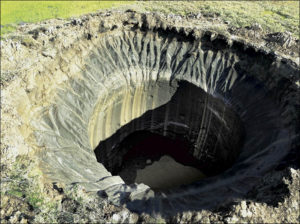Hundreds of Huge Craters Discovered in the Arctic Ocean – The Atlantic

Image Source: Vasily Bogoyavlensky
Article Synopsis – Methane is a powerful greenhouse gas. During the last Ice Age, methane was frozen in the Barents Sea, forming methane hydrates. As the ice melted, the methane was released. The pressure from the gas lifted the seafloor and sometimes exploded leaving giant craters. The mounds and craters can still be seen on the seafloor of the Barents Sea. A similar process may be creating the craters that have been spotted on land in Siberia in recent years where the permafrost has been melting. These blow outs could potentially release large quantities of methane into the atmosphere, further exacerbating global warming. To read the actual article click here.
